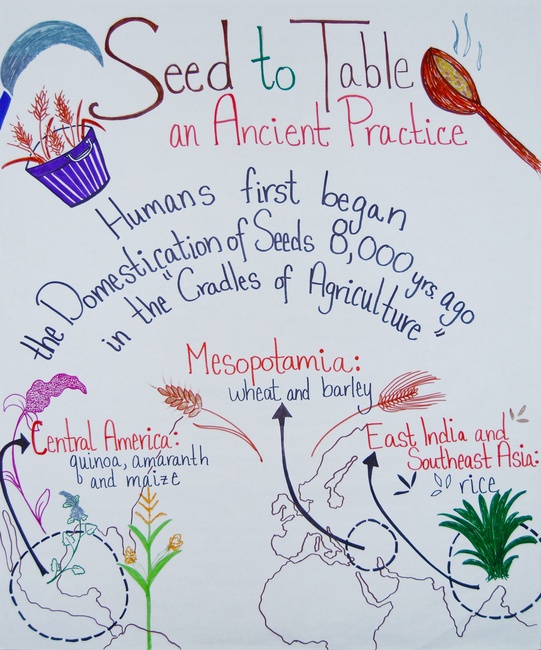Garden Humanities: Harvest, Thresh, and Winnow

Summary
In this 6th grade lesson, students learn how to harvest, thresh and winnow seasonal grains and play the game, Seed to Table.
Objectives
After this lesson, students will be able to:
- Harvest, thresh and winnow grain
- Summarize the seed to table cycle
Assessments
During this lesson, students will:
- Assess the ripeness of a seasonal grain, then harvest, thresh and winnow a stalk
- Explain each step of the seed to table cycle and arrange the illustrated cards of the Seed to Table game.
Materials
- Clippers
- Tarp, white cloth or bed sheet large enough for 8 students to sit, winnow and sift on
- Small bowls for winnowing
- Large bowls for capturing seed
- Sifting screens (3 different gauges: 1/4", 1/8", 1/16")
- Whole grain plants (quinoa, amaranth, barley or wheat)
- Seed to Table game cards
Before You Begin
- Make sure that seasonal grain is growing abundantly in the garden
- Collect all the materials, and then set up the tarp, screens and bowls to make the grain station
Procedures
At the Opening Circle
- Welcome students and introduce the lesson.
- Ask students if they have ever heard of the terms Harvest, Thresh and Winnow and define each term.
- Introduce the seasonal grain that students will be working with and explain what the grain will be used for after it has been harvested, threshed, and winnowed. (example: Greens over Grains, planting in the garden)
- Explain that the class will be divided into four groups. Two groups will begin at the grain station, while the other two will work on a garden job. Half way through class, the groups will switch.
- Explain to students that when they return to closing circle, they will play the game Seed to Table. Prompt students to think about what Seed to Table refers to and explain that every time students participate in a garden job, they are participating in the Seed to Table Cycle.
In the Field
- Walk students to the seasonal grain patch in the garden and give a brief history of the grain: Where is it native? What is the family? What characteristics does it have?
- Explain how we know when the grain is ripe and demonstrate how it is harvested.
- Have each student pick a bundle of grains, and instruct them to be careful not to shake or disturb the seeds in the plants yet.
At the Seed to Table Station
- Once everyone has a bundle of grain, gather students around the white cloth on the ground at the seed to table station. Demonstrate threshing the seed from the plant by rubbing the grain’s flowers between your hands over the cloth.
- Once all the seed has fallen from the stalk, gather all the seed and chaff in the center of the cloth and lower into a large bowl.
- Explain to students that the next steps will involve winnowing, which is separating the chaff from the seed.
- Demonstrate how to winnow by using the sifters and by blowing gently across the surface of the seeds. The chaff should blow off while the seeds remain in the bowl.
- Have students winnow
- Once the seed is winnowed, prompt students to think of two reasons for saving seeds- for cooking and to plant in the garden.
At the Closing Circle
- Pass the Seed to Table game cards out to students. Have the students describe what is shown in each illustrated card.
- Begin at one card and have students rearrange themselves so that the pictures represent a seed to table cycle. Keep in mind that there can be different sequences of cards that are correct.
- Ask for a volunteer to tell a story using the ordered cards as a guide. Remind students that the cycle repeats itself, and therefore can start at any point.
- Prompt students to think about a different order for the cards keeping in mind the Harvest, Thresh, and Winnow activity.
Vocabulary
Harvest
Thresh
Winnow
Chaff